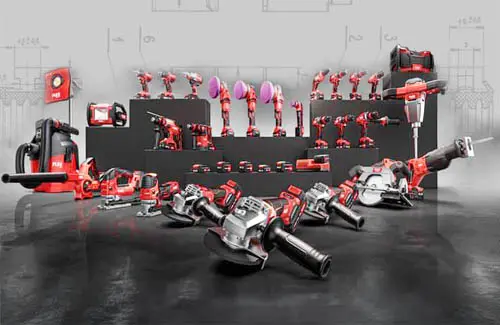The regular price is the current manufacturer's recommended price! FREE shipping for orders over EUR 41,67 within CZ+SK (PPLparcel)

We all know it. Electrification is a great thing, but who wants to constantly drag extension cords, look for sockets and untangle knots in power cables while working? Fortunately, manufacturers have come up with a solution in the form of batteries.
Thanks to this, the variability and mobility of work machines have expanded without dependence on a network connection. Which is clearly the biggest benefit.
The best-known manufacturers include FLEX, BOSCH, METABO, MAKITA, DeWALT or NAREX.
We can include drills, angle grinders, polishers, hammers, screwdrivers, impact wrenches, but also scissors or saws in cordless tools. However, we also come across blowers, spray guns, vacuum cleaners and so on.
Batteries:
Each manufacturer has its own batteries, usually compatible only with its own machines and chargers. However, the advantage is that you can use all machines with one battery.
Battery capacities are stated in milliampere-hours (mAh) or ampere-hours (Ah) and typically range from 1,000 to 10,000 mAh. The higher the capacity, the longer the battery will work.
We can calculate the battery life in hours by multiplying mAh by the number of volts (V) of the battery and dividing by 1,000.
How to choose battery capacity?
It is clear that the higher the number/number of mAh, the greater the capacity. But so is the price. It is therefore necessary to take into account the purpose for which we want to use the tool.
For hobby use, a lower battery capacity is sufficient, but if you want to use work machines more often or professionally, we recommend a higher capacity.
Battery cells are manufactured at a voltage of 1.2V. Machines and tools have the stated power as a multiple of this value, i.e. 10.8V, 12V, 14.4V, 18V, etc. While only 3.6V will be enough for ordinary cordless screwdrivers, grinders, saws and drills require a much higher voltage. An 18V battery is commonly used, which covers both hobby and professional use.
Therefore, if you are going to buy a set of work tools and machines from one brand, consider whether it is worth investing in a more powerful battery.
An undesirable effect of higher capacity batteries is their weight. The higher the capacity, the greater the weight.
What type of battery should you choose?
Ni-Cd (nickel-cadmium) and Ni-Mh (nickel-metal hydride) have not been produced for some time and have been replaced mainly by Li-ion (lithium-ion) batteries. These have a higher energy density, which means they are smaller, lighter and have a higher capacity. They also do not self-discharge, as was the case with older types of batteries.
How to store batteries?
To extend their lifespan as much as possible, they need to be stored at lower temperatures (5-15°C). It is therefore not ideal to leave them in a car for a long time in the summer, where they can lose up to 35% of their capacity at a temperature of about 40°C. Batteries do not mind freezing, but it is recommended that they reach room temperature before use. Do not charge a frozen battery under any circumstances! You could damage it. Do not charge the battery to 100% capacity before long-term storage, but do not leave it completely discharged.
Chargers:
They may differ in the number of batteries that can be charged at the same time, or the charging speed. It is ideal if you have at least two batteries. While you are working with one, you can charge the other without having to worry about having to interrupt your activity and wait for your discharged battery to recharge.
Slow charging takes several hours (approx. 3-5 hours). Fast chargers use a stronger current and can charge a 1.5 Ah battery in half an hour.
It is not recommended to use other types of chargers than those provided by the manufacturer for a specific type of battery.
Do not leave the battery plugged into the charger for a long time!
Did you know that:
Arthur James Arnot patented the world's first electric drill in 1889? However, it was far from the hand drill we know today. It was a drill for mining purposes. However, the first mention of a rechargeable battery cell was already in 1859.
Další články:
Typy vodováh
Pracovní obuv
Brusné a řezné kotouče
Svinovací metry